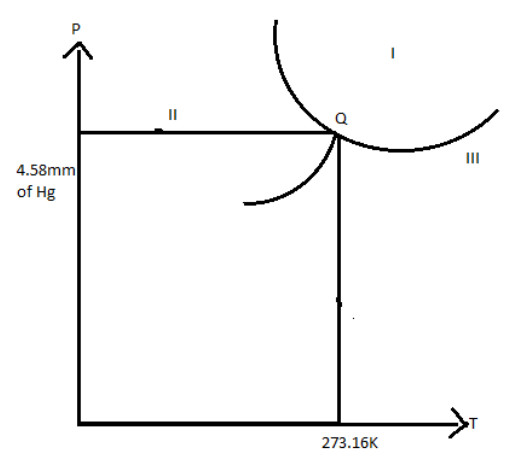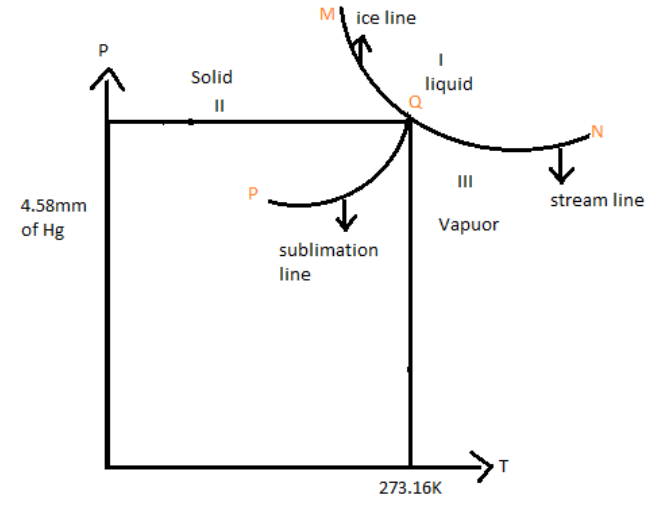
In the phase diagram shown, the point Q corresponds to the triple point of water the region

a. Liquid, solid, vapor
b. Solid, liquid, vapor
c. Liquid, vapor, solid
d. Solid, vapor, liquid.

Answer
478.8k+ views
1 likes
Hint: A substance can exist in all three phases- solids, liquid, and vapor under suitable conditions of temperature and pressure. With help of a phase diagram (P-T graph), the behavior of matter in different phases can be determined.
Complete step by step answer:
A Triple point is a point in the phase diagram representing a particular pressure and temperature at which the solid, liquid, and vapor can co-exist.
The solid (ice) and liquid (water) phases are in equilibrium at a temperature called the melting point or fusion point. Similarly, the temperature at which the liquid phase (water) and vapor phase (steam) are in equilibrium is called the boiling point. Similarly, the temperatures at which the solid phase (ice) and vapour phase (steam) are in equilibrium are called sublimation point. All these temperatures change with pressure. So, a phase diagram is obtained as shown in the figure.

All the three lines QM, QN, and PQ meet at a single point called triple point of water.
At the corresponding temperature and pressure, the three phases of water co-exist.
Hence, the correct answer is option (A).
Note: If the temperature at triple point is kept constant pressure increases slightly then the phase is liquid. Sublimation is the process of direct change from a solid-state to the vapor state. The temperature at which a liquid converts into vapor is called the boiling point.
Complete step by step answer:
A Triple point is a point in the phase diagram representing a particular pressure and temperature at which the solid, liquid, and vapor can co-exist.
The solid (ice) and liquid (water) phases are in equilibrium at a temperature called the melting point or fusion point. Similarly, the temperature at which the liquid phase (water) and vapor phase (steam) are in equilibrium is called the boiling point. Similarly, the temperatures at which the solid phase (ice) and vapour phase (steam) are in equilibrium are called sublimation point. All these temperatures change with pressure. So, a phase diagram is obtained as shown in the figure.

All the three lines QM, QN, and PQ meet at a single point called triple point of water.
At the corresponding temperature and pressure, the three phases of water co-exist.
Hence, the correct answer is option (A).
Note: If the temperature at triple point is kept constant pressure increases slightly then the phase is liquid. Sublimation is the process of direct change from a solid-state to the vapor state. The temperature at which a liquid converts into vapor is called the boiling point.
Latest Vedantu courses for you
Grade 11 Science PCM | CBSE | SCHOOL | English
CBSE (2025-26)
School Full course for CBSE students
₹41,848 per year
Recently Updated Pages
Master Class 11 Economics: Engaging Questions & Answers for Success

Master Class 11 Business Studies: Engaging Questions & Answers for Success

Master Class 11 Accountancy: Engaging Questions & Answers for Success

Master Class 11 English: Engaging Questions & Answers for Success

Master Class 11 Computer Science: Engaging Questions & Answers for Success

Master Class 11 Maths: Engaging Questions & Answers for Success

Trending doubts
State and prove Bernoullis theorem class 11 physics CBSE

1 ton equals to A 100 kg B 1000 kg C 10 kg D 10000 class 11 physics CBSE

State the laws of reflection of light

One Metric ton is equal to kg A 10000 B 1000 C 100 class 11 physics CBSE

1 Quintal is equal to a 110 kg b 10 kg c 100kg d 1000 class 11 physics CBSE

Difference Between Prokaryotic Cells and Eukaryotic Cells




